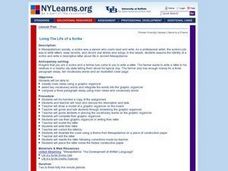Curated OER
Butterfly Introduction
First graders create a KWL chart about butterflies and then read a story about butterflies. In this butterflies lesson plan, 1st graders then discuss the life cycle, body, habits, and facts about butterflies as they read.
Curated OER
Problem/solution
Students examine presentations of problems and reaching solutions in literature. In this writing skills lesson plan, students read "The Three Little Pigs," and respond to several discussion questions about plot, characters, setting,...
Curated OER
Examining Letters to the Editor
Students write letters to the editor. In this written communication instructional activity, students read sample letters to the editor and use the active voice to compose letters to the editor about issues in which they are interested.
Curated OER
Noteworthy?
Why do we have CliffsNotes? SparkNotes? Middle and high schoolers examine arguments for and against the recent influx of book notes, or study guides. They stage a debate in which they represent Advocates For or Critics Against the use of...
Curated OER
What is a Fable?
Students read a variety of electronic Aesop's fables to define fable and moral, and write and illustrate an original fable. They then publish their fable using PowerPoint.
Curated OER
Beware the Ides of March
Sixth graders pretend to be the oracle warning Caesar about March 15th. They write a letter to Julius Caesar warning him of the consequences of going to the Senate building on March 15th. Students identify three causes and effects that...
Curated OER
Our Town: Using Song Lyrics in the Classroom
Bruce Springsteen’s “My Hometown” and Billy Joel’s “Allentown” motivate young lyricists to craft poems about their own home town. Groups compare the two songs, identifying details, symbols, and conflicts. Individuals then picture a place...
Curated OER
Living The Life of a Scribe
Students write a descriptive letter about life in ancient Mesopotamia. Through video streaming, students discover the history of Mesopotamia. They assume the role of a scribe and compose a three paragraph essay using main ideas and...
Curated OER
Writing Short Stories: The Fun Way
Do your young authors suffer from writer's block when they try to write short stories? Access their natural creativity with C-Gor, the writing monster! The instructional activity takes aspiring authors through a new writing process...
Curated OER
Career Magic
Fifth graders gather information about the roles, responsibilities, skills, and training and education requirements of workers. Then they input this information into a graphic organizer chart and identify the similarities and differences...
Curated OER
Click it! See it! Say it!
Scholars take digital photographs of a phonic cluster. Each child will use their digital pictures in a PowerPoint slide with text showing the sound and the word that contains that sound. Then they will take a picture of the object they...
Missouri Department of Elementary
Are You Balanced?
Balance scales create a strong visual of how an individual prioritizes one's self alongside their commitments to the community, school, and home. Scholars complete a graphic organizer then discuss their findings with their peers. A...
Curated OER
Telling Our Story
Middle schoolers develop a presentation. In this service instructional activity, students respond to how they felt participating in a service project and brainstorm ways they can continue to serve. Middle schoolers create a class...
Curated OER
Very Hungry Caterpillar
Students read "the Very Hungry Caerpiller" by Eric Carle and create their own caterpillers using the same art techniques found in the book in this excellent early elementary lesson. Included with the lesson is a vocabulary list and a...
Curated OER
Introduce Vocabulary: Arthur’s New Puppy
Learners are read Arthur's New Puppy, by Marc Brown. In this vocabulary focused lesson, students discover the definitions of at least three Tier Two words. They discuss the meaning of the new words, as a group, both before and after the...
Curated OER
Making a Choice
Students read and discuss the text Miss Rumphius. In this philanthropy lesson, students discuss how the characters in the book made the world beautiful and create a class book of good deeds.
Curated OER
Romeo and Juliet
Students survey the characters in Shakespeare's "Romeo and Juliet. Using Inspiration software, students create individual character webs for both Romeo and Juliet. Students describe the two main characters.
Curated OER
Emotions for ESL Students
You might get emotional during this activity - but don't worry, that's the idea! The class practices analyzing emotions, including their own, their peers' facial expressions, and colors and sounds that remind them of certain emotions....
Curated OER
Recognizing Cause and Effect
Learners define cause and effect and recognize an effect as something that happens as a result of a cause. They apply information they have learned about cause and effect to their study of literature.
Curated OER
The Business of Credit
Students explore the concept of credit. In this credit lesson, students discuss the necessities to start-up a new business. Students discuss cost of a new business, loans, and credit. Students create their own business and apply what...
English Worksheets Land
That Darn Cat!
Read about the darnedest can in two fables adapted from Aesop's Fables. Readers answer three reading comprehension questions that prompt them to compare and contrast animal characters in the two stories.
Curated OER
The Parts of a Newspaper
Tenth graders examine the parts of a newspaper. They observe a PowerPoint presentation. Students participate in a research project to recognize the different types of materials each newspaper section contains. They read, summarize, and...
Curated OER
Writing Example Paragraphs
Sixth graders write example paragraphs. The term "example paragraph" refers to a paragraph where the supporting sentences provide examples of the subject/idea described in the topic sentence. Students write a basic example paragraph...
Curated OER
Combining Syllables to Form 2- and 3-Syllable Words
Students practice combining consonant-vowel-consonant sounds to form words. They read closed and silent "e" syllables. Students construct two-syllable words. They arrange syllables to form three and four syllable words.























